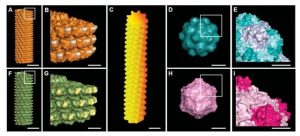 A team of researchers from the USA and Thailand have developed substrates based on virus nanoparticles which are able to enhance and accelerate the differentiation of stem cells into bone cells. These 2D substrates, coated in plant virus nanoparticles, were designed to exhibit unique nanoscale topographies, with the aim of investigating how these different topographical cues affect cell behavior.
A team of researchers from the USA and Thailand have developed substrates based on virus nanoparticles which are able to enhance and accelerate the differentiation of stem cells into bone cells. These 2D substrates, coated in plant virus nanoparticles, were designed to exhibit unique nanoscale topographies, with the aim of investigating how these different topographical cues affect cell behavior.
The cell’s topological environment is known to play an important role in cell growth and development, but research in this area has been hampered by the difficulty in controlling certain topological features, while preserving others. To combat this, the development of nanoengineered structures which are able to mimic a range of topographies under physiological conditions is highly desirable. Virus particles, possessing an array of multivalent coat proteins, are attractive building blocks for nanoengineering.
The team, from the University of South Carolina and Chulalongkorn University in Bangkok, discovered previously that substrates coated in tobacco mosaic virus particles significantly accelerated the osteogenesis of bone derived mesenchymal stem cells. They hypothesized that virus shape and surface topography were key to this accelerated osteogenesis, and developed a range of topologically distinct virus nanoparticle coated substrates to investigate this further. Scaffolds based on a range of plant viruses exhibiting distinct nanoscale topographies were produced by adsorbing the virus particles onto a biocompatible polymer. The stem cells were then cultured on these 2D scaffolds and the expression of osteogenic markers detected .The researchers propose that the enhanced osteogenesis observed results from stress caused by the unfavorable surfaces of the virus particles, which triggers an increase in cell motility and formation of cell aggregates.
The researchers aim to further investigate this topography-induced differentiation and hope to extend this research to other synthetic substrates, as well as investigate its application to clinical tissue engineering.
Advanced Science is a new journal from the team behind Advanced Materials, Advanced Functional Materials, and Small. The journal is fully Open Access and is free to read now at www.advancedscience.com.
















